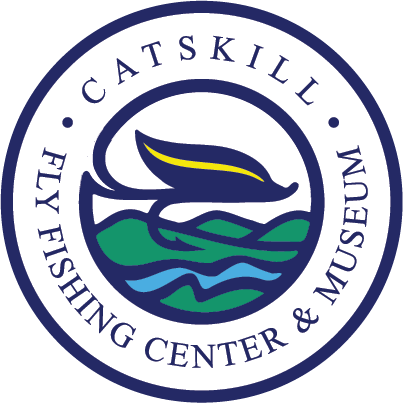Our History
Elsie Darbee and her husband Harry in their home shop
The Darbee kitchen was a place where many fly fisherman gathered to exchange stories and advice about their favorite sport. It was Elsie who kept bringing up the idea of a museum. She spoke of a place, somewhere in the Catskills, where the trout fishing tradition and spirit of the fly fishing community could be preserved and shared.
Support for the idea gained momentum and in July 1979, nine dedicated individuals met at the Sullivan County Bank in Roscoe to elect officers and a Board of Directors. The Catskill Museum of Fly Fishing as it was first called, was launched with Elsie Darbee as its first President.
When the Catskill Fly Fishing Center officially incorporated in 1981, its goals included not only a museum for the display of artifacts and memorabilia, but lively educational activities as well. While the search for a permanent site intensified, the Roscoe Theater building provided temporary housing for the first exhibits. With its picture window and downtown location, the museum attracted many passing anglers, tourists and invited guests. Former President Jimmy Carter stopped traffic on Main Street with his visit there in 1984 to help kick off a critical capital fundraising drive. His visit encouraged a widening circle of supporters.
The present location was found in 1982. With the help of visionary leadership, grassroots support and much hard work, this 35-acre farm along the banks of the Willowemoc has been transformed into the facility you see today. In May of 1986, a new steel bridge was installed. By early 1988, the farmhouse was renovated and a wing added for exhibit space. The old barn was resurrected as an educational facility and bunkhouses were built, making it possible for weekend educational programs for youth. Museum exhibits were mounted with care and concern, creating a warm and inviting environment for anglers and non-anglers alike. Those who worked on these projects will attest to the magnitude of the transformation and the incredible tenacity and energy of all the contributors.
With a gold shovel and many smiles, the ground breaking ceremony to kick off construction of the new museum building was celebrated on May 30, 1993. The building foundation was laid just before the snowy winter began and construction of the state-of-the-art museum building was completed by October, 1994.
On May 28th, 1995 we opened the doors of our award-winning, state-of-the-art museum which honors the heroes of the sport and expresses the lore and lure of fly fishing. During the inaugural ceremonies we were presented with the deed to “Junction Pool”, granting us stewardship over the cherished water where the main-stem of the Beaver Kill takes up its legendary flow. In 1998, we received additional parcels of land, increasing our size to 55.66 acres along a mile of accessible, prime, “No Kill”, trout water.
Our newest building was erected in 2010. Known as the Wulff Gallery and Heritage Craft Workshop, this building houses exhibits on Lee and Joan Wulff, as well as open space for exhibits, presentations and events. Downstairs is the Heritage Craft Workshop that includes a fly tying area and bamboo rod making workshop. This area also contains the Carmichael Garrison rod building collection.
We invite you to: wet a line in Wulff Run, walk our nature trail, view the informative exhibits the museum offers, picnic under our covered pavilion and interact with the fly tyers, rodmakers, environmentalists, and naturalists who present programs at the Center.
All who visit and enjoy this facility are witness to…
a dream realized.

